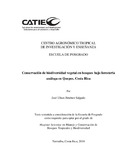| dc.description.abstract | De allí, que esta investigación busque describir el estado actual de los sistemas de Forestería Análoga que existen en Londres, con la intensión de contribuir al conocimiento sobre el potencial de la forestería análoga en cuanto a la conservación de la biodiversidad. En este estudio de caso, algunas lecciones aprendidas son resaltadas. Primero, el éxito logrado en la recuperación de un sistema degradado y su conversión a un sistema altamente productivo, aún sin el uso de fertilizantes químicos, plaguicidas o maquinaria pesada y segundo, que al darse una plaga de Fusarium sp. que acabo prácticamente con todo el cultivo de vainilla en la zona. Bekins bajo los principios y técnicas de la Forestería Análoga, aún podía producir 150 k por año, en esos momentos. Los bosques con la mayor diversidad de especies arbóreas con dap ≥ 10 cm, corresponden a los de Forestería Análoga, seguido del bosque natural. El Bosque natural presentó una media mayor y distinta de las demás en las variables: altura del dosel, número de árboles e índice de complejidad.
Therefore, this research aims to describe the current state of the Analog Forestry system that exist in Londres. Our intention is to make an academic contribution regarding the potential of Analog Forestry in the area of biodiversity conservation. In this case study, it is important to highlight some lessons learned. First, the success achieved in the recovery of a degraded system and its conversion to a highly productive system, even without the use of chemical fertilizers, pesticides or heavy machinery. Second, that under the principles and techniques of the Analog Forestry, we could produce 150 k per year of Bekins, at a time when a plague of Fusarium sp practically ended the vanilla crops in the zone. It was noticed that forests with the greatest diversity of tree species (with dap ≥ 10 cm), correspond to the of Analog Forestry, followed by the natural forest. The natural forest showed xii different and greater average values in variables such as: canopy height, number of trees and complexity index. | es_ES |


